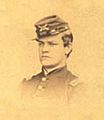Frank Wilkeson facts for kids
Frank Wilkeson was an American journalist, soldier, farmer, and explorer. He lived from 1848 to 1913. He wrote books about his experiences, including his time fighting in the Union Army. This was during the American Civil War. He was also one of the first people to explore and map the Cascade Pass in Washington.
Contents
Early Life and School
Frank Wilkeson was born in Buffalo, New York, in 1848. His family was well-known and wealthy. His father, Samuel Wilkeson, was a famous journalist. Frank's aunt was Elizabeth Cady Stanton, a well-known social activist. The family's neighbor was U.S. President Millard Fillmore.
Frank had an older brother named Bayard Wilkeson. Bayard was killed during the Civil War. This happened at the Battle of Gettysburg. He was leading an artillery unit at the time. Frank went to school in New London, Connecticut, and at Phillips Academy in Andover, Massachusetts.
Military Service
Frank's father, Samuel, reported on the Civil War for The New York Times. He was at Gettysburg when Bayard was killed. A year later, when Frank was 16, he ran away from home. On March 26, 1864, he joined the Union Army. He told them he was 18 and a farmer. He joined the 11th Battery of the New York Light Artillery.
Fighting in the War
Wilkeson was sent to Virginia to join the Army of the Potomac. He took part in General Ulysses S. Grant's Overland Campaign. His unit was not fighting in the Battle of the Wilderness. Frank was curious, so he left his unit without permission. He fought as an infantry soldier. He used a discarded rifle he found. He fought alongside General Winfield Scott Hancock's Second Corps.
The next day, he went back to his unit. He was punished for leaving. After that, he stayed with his unit. He fought in the Battle of Spotsylvania Court House, the Battle of Cold Harbor, and the start of the Siege of Petersburg.
Becoming an Officer
Because his family was important, Wilkeson was offered a promotion. He could become a second lieutenant in the 4th U.S. Artillery. He first said no to this offer during the Battle of Cold Harbor. But weeks later, at Petersburg, he accepted. He was feeling a lot of stress from the war. This is now called PTSD.
As an officer, he helped defend Washington, D.C.. Later, he guarded Confederate prisoners. This was at Elmira Prison in Upstate New York. Finally, he was sent to Chattanooga, Tennessee. The war was ending, and the country was rebuilding. He left the army in March 1866. He was honorably discharged.
Life After the War
After the war, Wilkeson worked as a mining engineer in Pennsylvania. He married Mary Crouse in 1869. They settled in Johnstown. In 1871, they moved to Gypsum, Kansas. There, they managed a large cattle ranch and wheat farm.
In the 1880s, Wilkeson wrote for several newspapers. These included The New York Times. He also wrote articles for magazines like Harper's Weekly.
Writing About the War
In 1887, he published a book about his time in the army. It was called Recollections of a Private Soldier in the Army of the Potomac, 1864–1865. The book was critical of how the war was managed. He felt some politicians and officers were not good leaders.
His book included a chapter called "How Men Die in Battle." This part described how soldiers were killed in combat. It also noted their facial expressions. Historians value this book for its honest style. It was reprinted in 1997. The new title was Turned Inside Out: Recollections of a Private Soldier in the Army of the Potomac.
Frank Wilkeson was also active in the Democratic Party. In 1908, he tried to become a representative for Kansas's 5th congressional district. However, he was not successful.
Later Years and Death
Wilkeson died on April 22, 1913. He passed away from problems related to diabetes. This happened at a hotel in Chelan, Washington. He was buried in Gypsum Hill Cemetery in Salina, Kansas.
Honors
The town of Wilkeson, Washington, was not named after Frank. It was named in honor of his father, Samuel Wilkeson.
Images for kids


